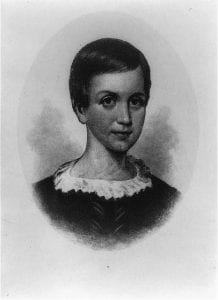I first read Emily Dickinson as an 18-year-old studying American poets for my English literature program at a Mumbai university. I was drawn to how her poems seemed intimate, yet distant at the same time. A figure of fascination for me, Dickinson returned to my life when I was 29. This time, I was sitting in an empty bathtub in an eerily quiet apartment while my five-month-old daughter slept blissfully in her crib on the other side of the door. I picked a random page from the Modern Library Classics edition of The Selected Poems of Emily Dickinson and read “As children bid the guest good-night,” searching for a moment of respite from the mind-numbing demands of new parenthood.
In this particular piece, Dickinson compared the love people have for their offspring to her affection for the flowers in her yard. For me, tired and delirious from nursing an infant who only slept for 40 minutes at a time, it was an assurance that my baby would eventually take longer naps, which would result in me finally taking a shower. Her poetry spoke compassionately to everyone — from an academic studying Victorian literature to a beleaguered new mom. Now, with the COVID-19 pandemic upending lives globally and forcing us to stay indoors for the collective good, I can’t help but invoke Dickinson’s words again.
You may unsubscribe from any of our newsletters at any time.
More on Broadview: Let’s stop judging others during COVID-19
Many scholars and fans consider Dickinson the patron saint of isolation for her unusual decision to lead a reclusive life in her prime and resist publishing her vast collection of poems while she was alive. “I think that relative isolation gave Dickinson time to reflect on what really mattered to her — that is, to step back a bit from the contingencies and responsibilities that fill our days and ask very big questions about death, immortality, loneliness, what it is that gives people joy, what it means to love,” says Cristanne Miller, SUNY Distinguished Professor and Edward H. Butler Professor in the English department at the University at Buffalo in New York.

Historians and scholars who have studied Dickinson note that the writer sat for hours at her window, observing and absorbing her surroundings in all their microscopic beauty, which produced some of the most moving poems about nature and time. “Her work has always been relevant but so much of it now connects. Like, ‘Unto my Books—so good to turn’ (for the many of us who are now finding more time to read) or ‘Kinsmen of the shelf,’ now that we can’t travel,” says Miller, who is also the former president of the Emily Dickinson International Society and an expert on the poet. “I also love poems such as ‘Delight is as the flight,’ reminding us that we cherish most that which is fleeting. This time of self-isolation reminds me of the preciousness of my relationships with people I now cannot see or touch.”
For some who find comfort in being productive during stressful times, Dickinson offers great inspiration. “Even when she was sitting in her room, watching life go on, with only a viewer’s distance on it, she was so productive and creative… seeing, thinking, feeling,” says Thomas Loebel, who specializes in 19th and 20th-century American literature and has taught selections of Dickinson’s poetry at both graduate and undergraduate levels. He’s also the dean of graduate studies and associate vice-president, graduate at York University in Toronto.
“It was a real engagement with a very active world,” he says. “She wasn’t in public, running down the streets or in the market, she’s watching life and she’s feeling her relation to it. And creating whole new forms of poetry. That is truly inspiring.”
A global pandemic also brings death in large numbers. Countries like Italy and U.S. have seen huge numbers of fatalities, and the grief we feel for our fellow humans — even those who are unrelated to us — is palpable. Dickinson was perceived to be fixated on the themes of death and suffering, which is reflected in a lot of her work. But how does one find comfort in her poems in this scenario?
“Her work has always been relevant but so much of it now connects.”
“People approaching death, or suffering ‘great pain’ as she says in ‘After great pain, a formal feeling comes’… turn to her writing for solace, since she gives them language to help focus their experience and fears,” notes Miller. Other themes include what the experience of pain feels like, how it leaves us (such as in “Pain—has an Element of Blank”), or whether repeated suffering is worse than death (“‘Twas like a Maelstrom, with a notch”).
Right now, as the curve flattens in some parts of the world while some brace for a second surge, how do we prepare for signs of life that spring is already bringing forth? By getting out of that cold bathtub and stepping into the light with Dickinson’s words:
“Spring is a happiness so beautiful, so unique, so unexpected, that I don’t know what to do with my heart.”
Correction: A previous version of this article incorrectly described Cristanne Miller as the English department chair at the University at Buffalo. This version has been updated.
Broadview is an award-winning progressive Christian magazine, featuring stories about spirituality, justice and ethical living. For more of our content, subscribe to the magazine today.















Dickinson is magic.